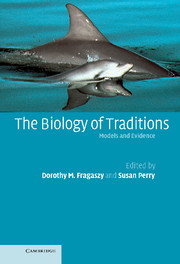Book contents
- Frontmatter
- Contents
- List of contributors
- Preface
- Acknowledgements
- 1 Towards a biology of traditions
- 2 What the models say about social learning
- 3 Relative brain size and the distribution of innovation and social learning across the nonhuman primates
- 4 Social learning about food in birds
- 5 The cue reliability approach to social transmission: designing tests for adaptive traditions
- 6 “Traditional” foraging behaviors of brown and black rats (Rattus norvegicus and Rattus rattus)
- 7 Food for thought: social learning about food in feeding capuchin monkeys
- 8 Traditions in mammalian and avian vocal communication
- 9 Like mother, like calf: the ontogeny of foraging traditions in wild Indian Ocean bottlenose dolphins (Tursiops sp.)
- 10 Biological and ecological foundations of primate behavioral tradition
- 11 Local traditions in orangutans and chimpanzees: social learning and social tolerance
- 12 Developmental perspectives on great ape traditions
- 13 Do brown capuchins socially learn foraging skills?
- 14 Traditions in wild white-faced capuchin monkeys
- 15 Conclusions and research agendas
- Further reading
- Index
- References
1 - Towards a biology of traditions
Published online by Cambridge University Press: 27 October 2009
- Frontmatter
- Contents
- List of contributors
- Preface
- Acknowledgements
- 1 Towards a biology of traditions
- 2 What the models say about social learning
- 3 Relative brain size and the distribution of innovation and social learning across the nonhuman primates
- 4 Social learning about food in birds
- 5 The cue reliability approach to social transmission: designing tests for adaptive traditions
- 6 “Traditional” foraging behaviors of brown and black rats (Rattus norvegicus and Rattus rattus)
- 7 Food for thought: social learning about food in feeding capuchin monkeys
- 8 Traditions in mammalian and avian vocal communication
- 9 Like mother, like calf: the ontogeny of foraging traditions in wild Indian Ocean bottlenose dolphins (Tursiops sp.)
- 10 Biological and ecological foundations of primate behavioral tradition
- 11 Local traditions in orangutans and chimpanzees: social learning and social tolerance
- 12 Developmental perspectives on great ape traditions
- 13 Do brown capuchins socially learn foraging skills?
- 14 Traditions in wild white-faced capuchin monkeys
- 15 Conclusions and research agendas
- Further reading
- Index
- References
Summary
Introduction
One who sees things from the beginning will have the finest view of them
Attributed to AristotleIn late 1997, a series of exchanges occurred on the internet bulletin board established by Linda Fedigan a year earlier to facilitate communication among the select circle of individuals studying capuchin monkeys (genus Cebus, in the family Cebidae of the New World monkeys). Someone posted a description of a strikingly odd behavior she had noticed in her main study group of about two dozen white-faced capuchin monkeys (C. capucinus). The behavior, a pattern of two individuals interacting in an apparently affiliative manner, had not been described in the literature for any other animal species. Several members of the group performed this behavior with each other routinely over a period of seven years, and it appeared a perfectly familiar aspect of their social behavior that field season, as if they always did this odd thing (see Ch. 14, for more details about the mystery behavior). Nevertheless, they had not done this during the first year of the study, nor had she observed the behavior in the neighboring group. The researcher was understandably curious whether anyone else had ever seen anything like it, or had any ideas on how it might have originated or its function. A flurry of messages ensued over the next few weeks, with several researchers confirming the first person's suspicion that this behavior was not a universal behavior in white-faced capuchins, and not known at all in other species of capuchins.
- Type
- Chapter
- Information
- The Biology of TraditionsModels and Evidence, pp. 1 - 32Publisher: Cambridge University PressPrint publication year: 2003
References
- 41
- Cited by

